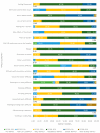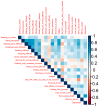Assessment of the Physical and Emotional Health-Related Quality of Life Among Congestive Heart Failure Patients with Preserved and Reduced Ejection Fraction at a Quaternary Care Teaching Hospital in Coastal Karnataka in India
- PMID: 40805907
- PMCID: PMC12346822
- DOI: 10.3390/healthcare13151874
Assessment of the Physical and Emotional Health-Related Quality of Life Among Congestive Heart Failure Patients with Preserved and Reduced Ejection Fraction at a Quaternary Care Teaching Hospital in Coastal Karnataka in India
Abstract
Introduction: Congestive heart failure (CHF), a complex clinical syndrome characterized by the heart's inability to pump blood effectively due to structural or functional impairments, is a growing public health concern, with profound implications for patients' physical and emotional well-being. In India, the burden of CHF is rising due to aging demographics and increasing prevalence of lifestyle-related risk factors. Among the subtypes of CHF, heart failure with preserved ejection fraction (HFpEF), i.e., heart failure with left ventricular ejection fraction of ≥50% with evidence of spontaneous or provokable increased left ventricular filling pressure, and heart failure with reduced ejection fraction (HFrEF), i.e., heart failure with left ventricular ejection fraction of 40% or less and is accompanied by progressive left ventricular dilatation and adverse cardiac remodeling, may present differing impacts on health-related quality of life (HRQoL), i.e., an individual's or a group's perceived physical and mental health over time, yet comparative data remains limited. This study assesses HRQoL among CHF patients using the Minnesota Living with Heart Failure Questionnaire (MLHFQ), one of the most widely used health-related quality of life questionnaires for patients with heart failure based on physical and emotional dimensions and identifies sociodemographic and clinical variables influencing these outcomes. Methods: A cross-sectional analytical study was conducted among 233 CHF patients receiving inpatient and outpatient care at the Department of Cardiology at a quaternary care teaching hospital in coastal Karnataka in India. Participants were enrolled using convenience sampling. HRQoL was evaluated through the MLHFQ, while sociodemographic and clinical characteristics were recorded via a structured proforma. Statistical analyses included descriptive measures, independent t-test, Spearman's correlation and stepwise multivariable linear regression to identify associations and predictors. Results: The mean HRQoL score was 56.5 ± 6.05, reflecting a moderate to high symptom burden. Patients with HFpEF reported significantly worse HRQoL (mean score: 61.4 ± 3.94) than those with HFrEF (52.9 ± 4.64; p < 0.001, Cohen's d = 1.95). A significant positive correlation was observed between HRQoL scores and age (r = 0.428; p < 0.001), indicating that older individuals experienced a higher burden of symptoms. HRQoL also varied significantly across NYHA functional classes (χ2 = 69.9, p < 0.001, ε2 = 0.301) and employment groups (χ2 = 17.0, p < 0.001), with further differences noted by education level, gender and marital status (p < 0.05). Multivariable linear regression identified age (B = 0.311, p < 0.001) and gender (B = -4.591, p < 0.001) as significant predictors of poorer HRQoL. Discussion: The findings indicate that patients with HFpEF experience significantly poorer HRQoL than those with HFrEF. Older adults and female patients reported greater symptom burden, underscoring the importance of demographic-sensitive care approaches. These results highlight the need for routine integration of HRQoL assessment into clinical practice and the development of comprehensive, personalized interventions addressing both physical and emotional health dimensions, especially for vulnerable subgroups. Conclusions: CHF patients, especially those with HFpEF, face reduced HRQoL. Key factors include age, gender, education, employment, marital status, and NYHA class, underscoring the need for patient-centered care.
Keywords: Minnesota living with heart failure questionnaire (MLHFQ); NYHA classification; chronic disease burden; congestive heart failure (CHF); health-related quality of life (HRQoL); heart failure with preserved ejection fraction (HFpEF); heart failure with reduced ejection fraction (HFrEF).
Conflict of interest statement
The authors declare no conflicts of interest.
Figures
Similar articles
-
Prescription of Controlled Substances: Benefits and Risks.2025 Jul 6. In: StatPearls [Internet]. Treasure Island (FL): StatPearls Publishing; 2025 Jan–. 2025 Jul 6. In: StatPearls [Internet]. Treasure Island (FL): StatPearls Publishing; 2025 Jan–. PMID: 30726003 Free Books & Documents.
-
Investigation and analysis of mental health status of the older adult in western rural areas.Front Public Health. 2025 Jul 16;13:1612600. doi: 10.3389/fpubh.2025.1612600. eCollection 2025. Front Public Health. 2025. PMID: 40740371 Free PMC article.
-
Computer and mobile technology interventions for self-management in chronic obstructive pulmonary disease.Cochrane Database Syst Rev. 2017 May 23;5(5):CD011425. doi: 10.1002/14651858.CD011425.pub2. Cochrane Database Syst Rev. 2017. PMID: 28535331 Free PMC article.
-
The Effect of Weight Loss Through Lifestyle Interventions in Patients With Heart Failure With Preserved Ejection Fraction-A Systematic Review and Meta-Analysis of Randomised Controlled Trials.Heart Lung Circ. 2024 Feb;33(2):197-208. doi: 10.1016/j.hlc.2023.11.022. Epub 2024 Feb 6. Heart Lung Circ. 2024. PMID: 38320881
-
Sexual Harassment and Prevention Training.2024 Mar 29. In: StatPearls [Internet]. Treasure Island (FL): StatPearls Publishing; 2025 Jan–. 2024 Mar 29. In: StatPearls [Internet]. Treasure Island (FL): StatPearls Publishing; 2025 Jan–. PMID: 36508513 Free Books & Documents.
References
-
- D’Souza P.J.J., George L.S., Paramasivam G., Devasia T., Ravishankar N., Nayak B.S., Noronha J., Kusumavathi P., George A. Symptom perception, health-related quality of life and predicted survival in heart failure patients. Clin. Epidemiol. Glob. Health. 2024;22:101754. doi: 10.1016/j.cegh.2024.101754. - DOI
LinkOut - more resources
Full Text Sources




